Permanent Tissue
The cells that are formed by the meristematic tissues often have to take a certain role in the plant and thus, they lose their ability to divide and form more cells. They then become the permanent tissues of the plants.
- Differentiation - The process by which cells of the meristematic tissues convert themselves into a permanent tissue by taking a fixed shape, size and function is called differentiation.
- Types of Permanent Tissues:
- Simple Permanent Tissues
- Complex Permanent Tissues
- Parenchyma
- Chlorenchyma
- Aerenchyma
- Collenchyma
- Sclerenchyma
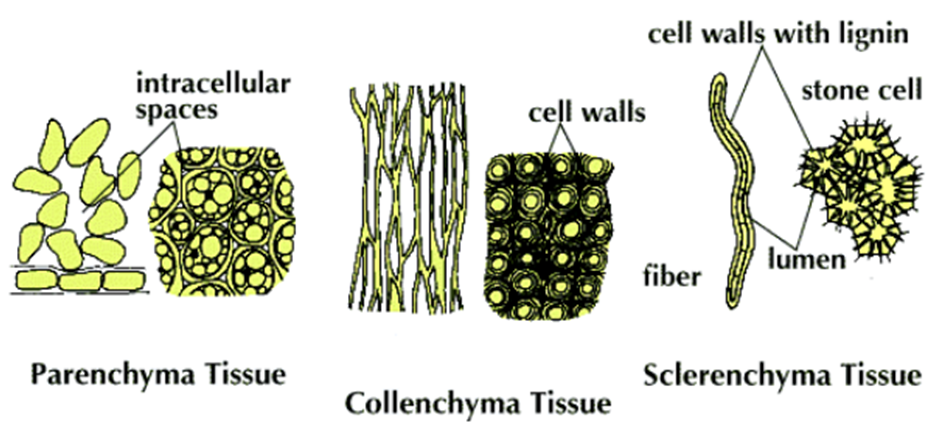
|
Parenchyma |
Collenchyma |
Sclerenchyma |
|
These tissues are responsible for photosynthesis, storage of food, gaseous exchange and floating of plants. |
These tissues are responsible for providing flexibility to the plants so that they can bend easily. |
These tissues are responsible for making plants hard and rigid. |
|
They are a group of living cells with cell wall made of cellulose. |
They are a group of living cells with cell wall made of cellulose and pectin. |
They are made up of dead cells having cell wall made of lignin. |
|
The parenchyma cells have large intercellular spaces between them. |
They have a little intercellular space in between them. |
The cells do not have any intercellular spaces. |
|
There are thin walls that surround each cell. |
The cells present in these tissues are broad and irregularly thick at corners. |
The cells have a long structure with thick walls. |
|
They are found in leaves and newly formed branches. |
They are present in leaves and stems of a plant. |
They are found in stems, veins of the leaves and coverings of nuts and seeds. |
Chlorenchyma
- These tissues are similar to that of parenchyma but they also contain chlorophyll in them.
- Due to the presence of chlorophyll, they are capable of performing the process of photosynthesis in plants.
Aerenchyma
- They are found in aquatic plants.
- They are also similar in structure to that of the parenchyma but they have large air cavities in them.
- These cavities allow the aquatic plants to float in water.
What is Lignin?
The cell walls of dead cells have a substance called lignin in them which provides rigidity to the cells. Lignin acts as the cement for the cells.
Epidermis
- The outermost layer of the cell is known as the Epidermis.
- It covers the entire plant.
- It is a thin layer of single cells but in places with less water, the epidermis of the plants can become thick in order to avoid frequent water loss.
- The cells are flat and they have no intercellular spaces between them.
- The outer walls of the epidermal cells are thick and the inner walls are thin.
- The epidermal cells often have long hair-like structures in roots which facilitate the absorption of water.
- The main function of the epidermis is to protect the plants from fungi, water loss and any injuries by secrets a wax-like water-resistant substance called as Cuticle on the surface of the plants which protects the plants.
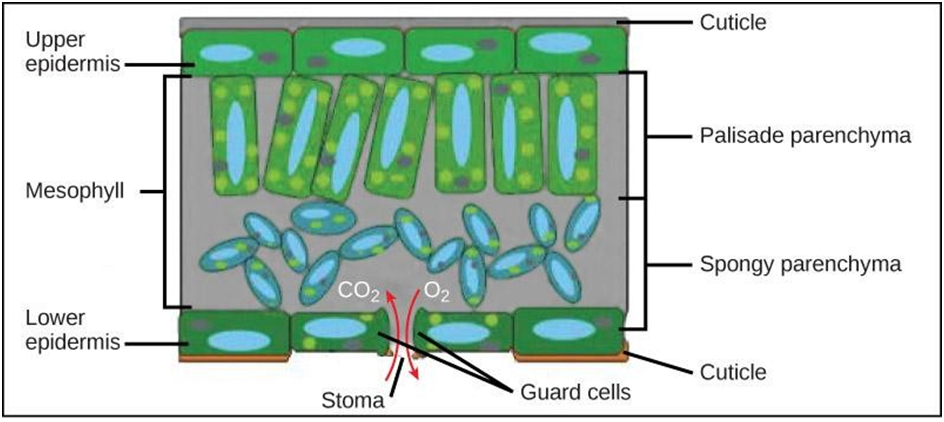
Stomata
- Stomata are pore-like structures that are present in the epidermis of the leaves.
- These pores are enclosed by two cells that have a similar shape as a kidney. These are called Guard Cells of Stomata. Guard cells are modified epidermal cells.
- Guard cells are responsible for the exchange of gases and transpiration.
Why do plants in desert areas have a waxy coating of cutin over them?
The epidermis cells of plants that are found in deserts have a waxy coating of cutin over them because it prevents water loss from the plants surface since water is already scarce in such areas.
Why do branches of old trees are different than the stems of a new plant?
- As a plant grows older the meristematic cells start covering the upper layer of the plants instead of the epidermis.
- These are the dead cells that have no special function in the plants but to provide them rigidity. They make the branches of the plants thick.
- This is often called the Bark or the thick cork of the tree.
- The bark of the trees contains a substance called Suberin which makes it waterproof and does not allow gaseous exchanges.
Complex Permanent Tissues
Complex Permanent Tissues comprise of different kinds of cells. These different types of cells coordinate with each other and perform a common function in these tissues. Two Complex Permanent Tissues are
Xylem and Phloem.
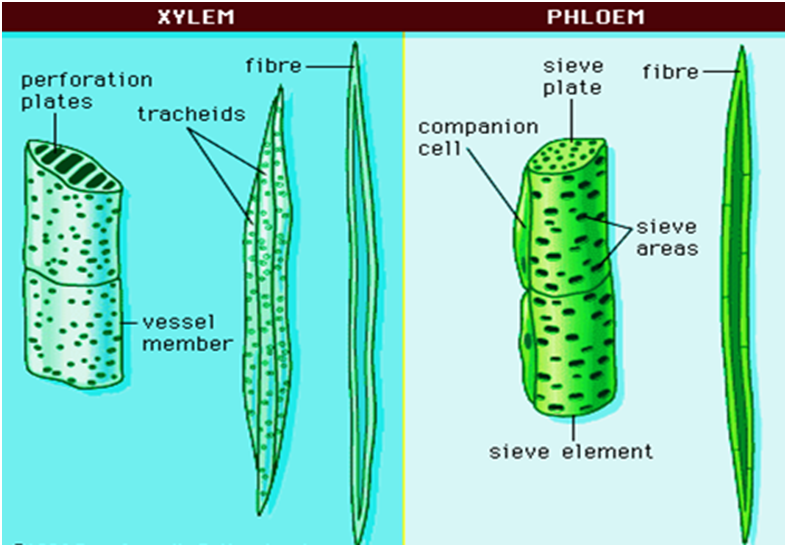
Xylem and Phloem
Similarities between Xylem & Phloem
- Their main function is to carry food and water in the plant.
- Both have a vascular bundle which is a conductive tissue in plants that helps them survive in different environmental conditions.
Xylem
Xylem is made up of dead cells having a thick cell lining. It consists of following elements-
- Tracheids and Vessels – They have broad tubular structure so that we can allow transportation of food and water in the plants vertically.
- Xylem Parenchyma – It stores food and helps in transportation of water horizontally in the plants.
- Xylem Fibers – They support transportation
Phloem
Phloem is made up of living cells and it allows the movement of food from leaves to other parts of the plant. It has the following elements –
Sieve Tubes – Broad shaped cells with porous walls
- Companion Cells – They facilitate the functions of the sieve tubes
- Phloem Fibers – Provide flexibility to the phloem
- Phloem Parenchyma – Stores starch and proteins
|
|
Xylem |
Phloem |
|
Made of |
Dead Cells |
Living Cells |
|
Cell wall thickness |
Thick |
Thin |
|
Cell wall material |
Lignin (rigid) |
Celluloses |
|
Permeability |
Impermeable |
Permeable |
|
Cytoplasm |
None |
Cytoplasm lining |
|
Transports… |
Water & minerals |
Food |
|
Carried to…. |
Leaves |
Growing parts & storage organs |
|
Direction of flow |
Upwards |
Up & down |
|
Tissue alos has … |
Fibres |
Companion cells |
- Books Name
- Yash Tyagi Coaching Science Book
- Publication
- ACERISE INDIA
- Course
- CBSE Class 9
- Subject
- Science
Permanent Tissues
Permanent Tissues
There are certain meristematic cells that can not divide throughout their life. They actually lose their tendency to form new cells. As a result, they form another tissue that is Permanent. They have particular functions except forming new cells. These tissues are derived from the meristematic tissue but their cells have lost the power of division. They are of two types:
- Simple permanent tissue
- Complex permanent tissue
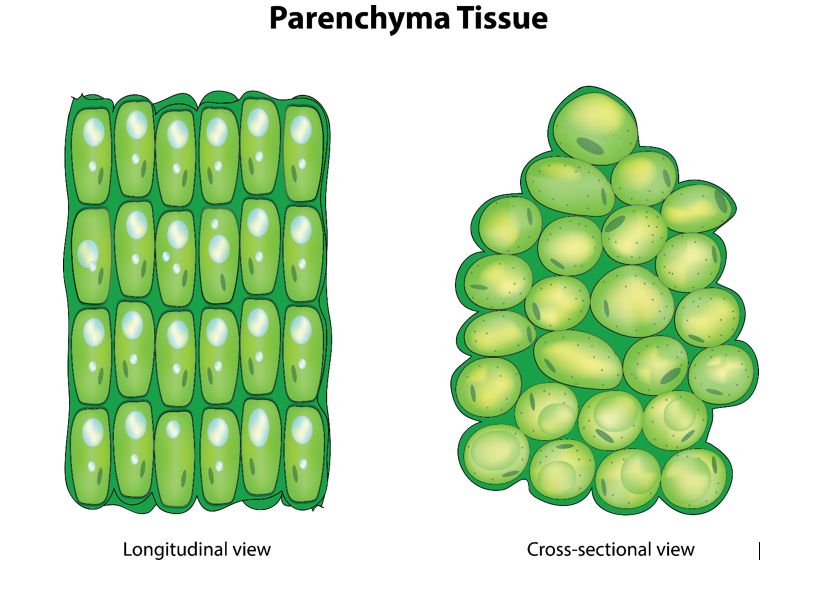
Simple permanent tissues
These tissues are composed of cells which are structurally and functionally similar. Thus, these tissues are all made of one type of cells. Depending upon the composition and function they are further classified into three types:
- Parenchyma
- Collenchyma
- Sclerenchyma
Let us learn about the difference between the three:
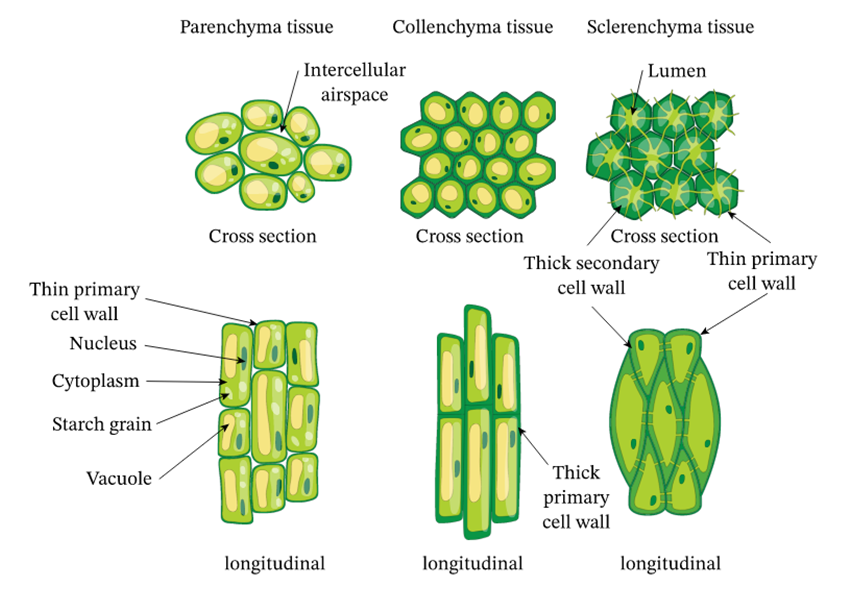
Parenchyma
This tissue is widely distributed in plant body such as stem, roots, leaves, flowers and fruits. It performs various functions and also has distinct features in xerophytes and hydrophytes. Let us see the features it possesses.
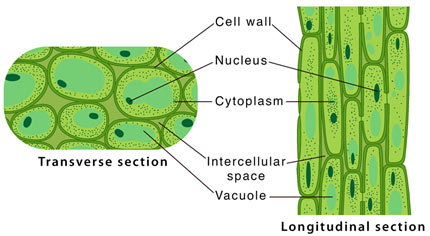
Characteristics
- Parenchyma cells are living and possess the power of division.
- The cells are rounded or isodiametric that isequally expanded in all sides.
- The parenchymatous cells are oval, round, polygonal or elongated in shape.
- The cell wall is thin and enclosed but dense cytoplasm which contains a small nucleus.
- Intercellular spaces are present
Functions
1. Parenchyma serves as a packing tissue.
2. Parenchyma acts as the main support to the stem.
3. Parenchyma serves as food storage tissue.
4. It helps in transporting materials.
5. It allows gaseous exchange.
6. It stores waste products of plants.
7. If chloroplast is present, the parenchyma tissue is called chlorenchyma and it helps in performing photosynthesis.
8. In hydrophytes large air cavities present called arenchyma that provide buoyancy to plants.
Collenchyma
You must have seen that some plant parts can bend without breaking. This feature is due to the presence of a mechanical tissue called collenchymas. They are generally found below epidermis of dicot stem and petiole. They also occur in midribs of dicot leaves but are absent in monocots.
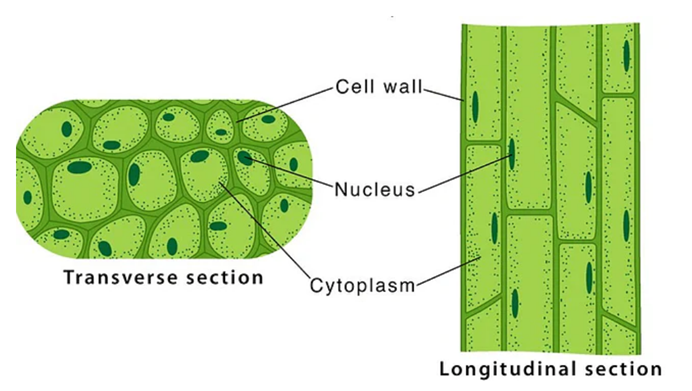
Characteristics
- They are living cells.
- They are characterized by the deposition of extra cellulose at the corners of the cells.
- The intercellular spaces are generally absent.
Functions
- It is a mechanical tissue so, it provides mechanical support to plant and its parts.
- It also provides strength and flexibility.
Sclerenchyma
You all have used and seen coconut for various purposes like performing some rituals, for eating, drinking coconut water, etc. The husk that is found outside the coconut looks like thin fibres and is hard too. This is made up of cells that is Sclerenchyma. Let us study about it.
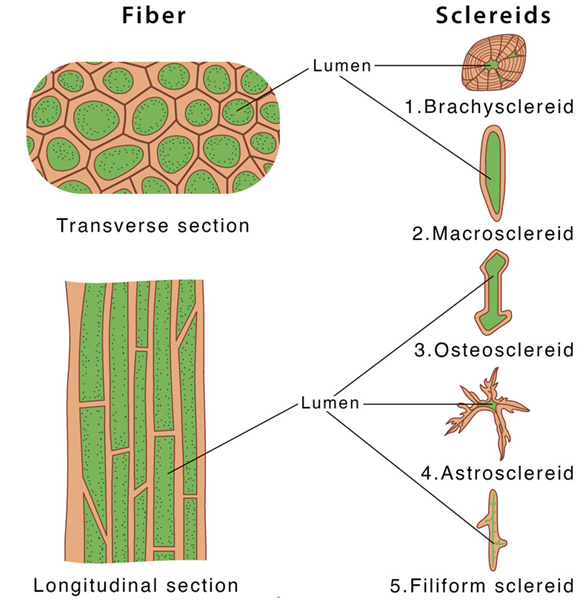
Characteristics
- They are actually dead cells.
- The walls of these cells are thickened with deposition of lignin.
- There are no intercellular spaces.
Cells of sclerenchyma are basically of two types:
- Fibres
- Sclereids
Fibres: They consist of very long, narrow, thick and lignified cells. They are usually pointed at both ends.
Sclereids: They are irregular in shape. They are also dead and are found under different parts like cortex, pith, phloem, etc.
Both fibres and sclereids have thin areas on them that are called pits.
Functions
- They provide mechanical support andare protective in nature.
Protective tissue
Plants and plant parts also need protection from external factors. So, there are certain tissues that perform this action. Let us learn about them. It includes epidermis and cork (or phellem).
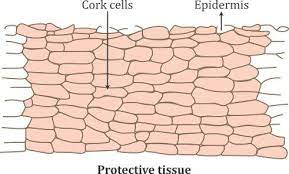
Epidermis
Epidermis is one cell thick layer and is covered with cuticle. It is a waterproof layer as it has a waxy substance called cutin. The cells of the epidermis are elongated and flattened and do not contain any intracellular space. Function of the epidermis is to protect the plant from desiccation and infection.
Cork
As plants grow older, epidermis undergoes certain changes and transforms into phellogen or cork. The cambium cells of cork are rectangular and are dead. The walls of cork cells are heavily thickened by the deposition of suberin which makes these cells impermeable to water and gases. Cork cells prevent desiccation, infection and mechanical injury.
Stomata
Epidermis of a leaf has small pores, called stomata. Each stoma is bounded by specialized epidermal cells called guard cells. These Guard cells are the epidermal cells only and contain chloroplasts. The stoma allows gaseous exchange to occur during photosynthesis and respiration.
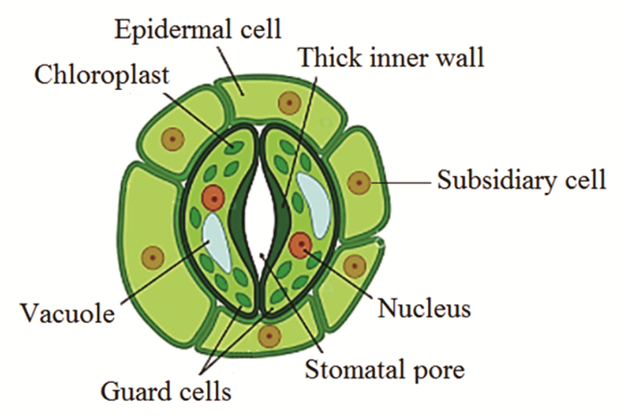
Complex permanent tissues
You all know that green plants can carry out photosynthesis and also absorb water through roots. But it may make you curious to know that how these substances are transported to whole plant. As we know, they don’t have blood, lymph or so. It is due to this complex tissue that water is transported and food is translocated. Let us learn about it. They consist of more than one type of cells. They are of the following two types:
- Xylem
- Phloem
Xylem and phloem are popularly known as vascular tissues
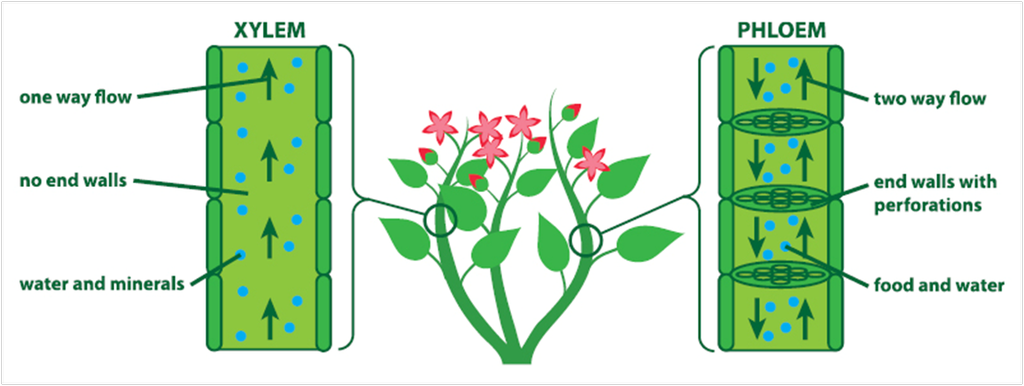
Xylem
Xylem is composed of cells with four different parts:
- Tracheids
- Vessels
- Xylem parenchyma
- Xylem sclerenchyma.
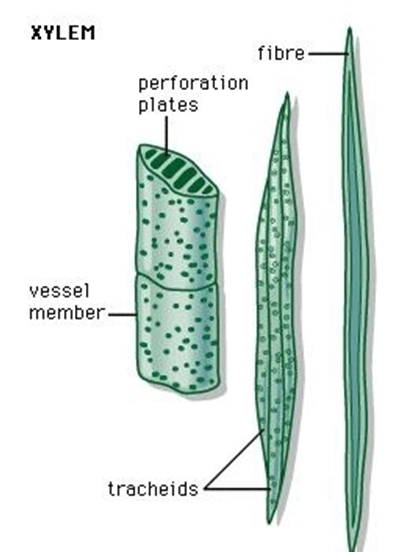
Except xylem parenchyma, all other xylem elements are dead and bounded by thick lignified walls. Vessels are shorter and wider than tracheid. Vessels are very long tube-like structures. Tracheids are elongated cells with tapering ends. They also conduct water. Since, tracheids do not have open ends like vessel, so the water has to pass from cell to cell via the pits.
Functions
- The main function of xylem is to carry water and mineral salts upward from the root to different parts of shoots.
- Since walls of tracheids vessels and sclerenchyma of xylem are lignified they give mechanical strength to the plant body.
Phloem
It consists of four components:
- Sieve tubes
- Companion cells
- Phloem parenchyma
- Phloem fibres.
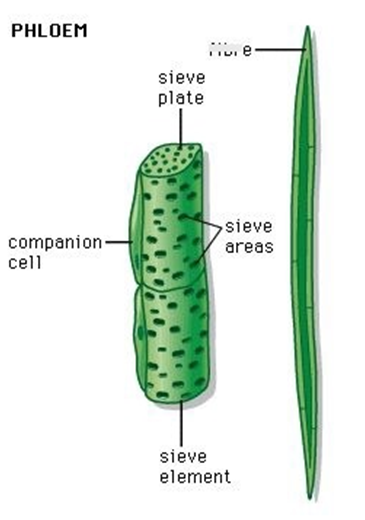
Sieve tubes
Sieve tubes are slenderical tube –like structures composed of elongated thin-walled cells, placed end to end. Their end walls are perforated by numerous pores and are called sieve plates.
Companion Cells
They are small thin-walled cells containing dense and very active cytoplasm and large elongated nucleus.
Functions
- Photo-synthetically prepared food materials are transported from the leaves to the storage organs.

 Vaishnav Publication
Vaishnav Publication
 ACERISE INDIA
ACERISE INDIA
